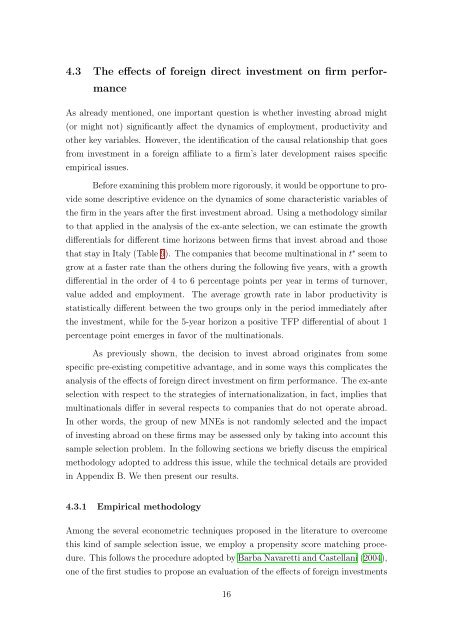n?u=RePEc:bdi:wptemi:td_1011_15&r=eff
n?u=RePEc:bdi:wptemi:td_1011_15&r=eff
n?u=RePEc:bdi:wptemi:td_1011_15&r=eff
- No tags were found...
Create successful ePaper yourself
Turn your PDF publications into a flip-book with our unique Google optimized e-Paper software.
4.3 The effects of foreign direct investment on firm performanceAs already mentioned, one important question is whether investing abroad might(or might not) significantly affect the dynamics of employment, productivity andother key variables. However, the identification of the causal relationship that goesfrom investment in a foreign affiliate to a firm’s later development raises specificempirical issues.Before examining this problem more rigorously, it would be opportune to providesome descriptive evidence on the dynamics of some characteristic variables ofthe firm in the years after the first investment abroad. Using a methodology similarto that applied in the analysis of the ex-ante selection, we can estimate the growthdifferentials for different time horizons between firms that invest abroad and thosethat stay in Italy (Table 9). The companies that become multinational in t ∗ seem togrow at a faster rate than the others during the following five years, with a growthdifferential in the order of 4 to 6 percentage points per year in terms of turnover,value added and employment. The average growth rate in labor productivity isstatistically different between the two groups only in the period immediately afterthe investment, while for the 5-year horizon a positive TFP differential of about 1percentage point emerges in favor of the multinationals.As previously shown, the decision to invest abroad originates from somespecific pre-existing competitive advantage, and in some ways this complicates theanalysis of the effects of foreign direct investment on firm performance. The ex-anteselection with respect to the strategies of internationalization, in fact, implies thatmultinationals differ in several respects to companies that do not operate abroad.In other words, the group of new MNEs is not randomly selected and the impactof investing abroad on these firms may be assessed only by taking into account thissample selection problem. In the following sections we briefly discuss the empiricalmethodology adopted to address this issue, while the technical details are providedin Appendix B. We then present our results.4.3.1 Empirical methodologyAmong the several econometric techniques proposed in the literature to overcomethis kind of sample selection issue, we employ a propensity score matching procedure.This follows the procedure adopted by Barba Navaretti and Castellani (2004),one of the first studies to propose an evaluation of the effects of foreign investments16



